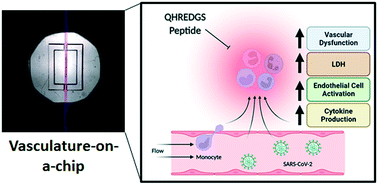Vasculature-on-a-chip platform with innate immunity enables identification of angiopoietin-1 derived peptide as a therapeutic for SARS-CoV-2 induced inflammation†
Abstract
Coronavirus disease 2019 (COVID-19) was primarily identified as a novel disease causing acute respiratory syndrome. However, as the pandemic progressed various cases of secondary organ infection and damage by severe respiratory syndrome coronavirus 2 (SARS-CoV-2) have been reported, including a breakdown of the vascular barrier. As SARS-CoV-2 gains access to blood circulation through the lungs, the virus is first encountered by the layer of endothelial cells and immune cells that participate in host defense. Here, we developed an approach to study SARS-CoV-2 infection using vasculature-on-a-chip. We first modeled the interaction of virus alone with the endothelialized vasculature-on-a-chip, followed by the studies of the interaction of the virus exposed-endothelial cells with peripheral blood mononuclear cells (PBMCs). In an endothelial model grown on a permeable microfluidic bioscaffold under flow conditions, both human coronavirus (HCoV)-NL63 and SARS-CoV-2 presence diminished endothelial barrier function by disrupting VE-cadherin junctions and elevating the level of pro-inflammatory cytokines such as interleukin (IL)-6, IL-8, and angiopoietin-2. Inflammatory cytokine markers were markedly more elevated upon SARS-CoV-2 infection compared to HCoV-NL63 infection. Introduction of PBMCs with monocytes into the vasculature-on-a-chip upon SARS-CoV-2 infection further exacerbated cytokine-induced endothelial dysfunction, demonstrating the compounding effects of inter-cellular crosstalk between endothelial cells and monocytes in facilitating the hyperinflammatory state. Considering the harmful effects of SARS-CoV-2 on endothelial cells, even without active virus proliferation inside the cells, a potential therapeutic approach is critical. We identified angiopoietin-1 derived peptide, QHREDGS, as a potential therapeutic capable of profoundly attenuating the inflammatory state of the cells consistent with the levels in non-infected controls, thereby improving the barrier function and endothelial cell survival against SARS-CoV-2 infection in the presence of PBMC.

- This article is part of the themed collections: Coronavirus articles - free to access collection and Lab on a Chip HOT Articles 2022


 Please wait while we load your content...
Please wait while we load your content...